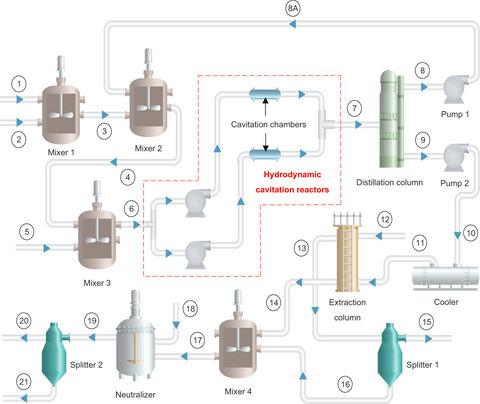当前位置:
X-MOL 学术
›
Energy Sci. Eng.
›
论文详情
Our official English website, www.x-mol.net, welcomes your
feedback! (Note: you will need to create a separate account there.)
Techno-economic assessment and sensitivity analysis of biodiesel production intensified through hydrodynamic cavitation
Energy Science & Engineering ( IF 3.5 ) Pub Date : 2021-07-07 , DOI: 10.1002/ese3.941 Ali Gholami 1 , Fathollah Pourfayaz 1 , Amirali Saifoddin 1
Energy Science & Engineering ( IF 3.5 ) Pub Date : 2021-07-07 , DOI: 10.1002/ese3.941 Ali Gholami 1 , Fathollah Pourfayaz 1 , Amirali Saifoddin 1
Affiliation

|
Since the last two decades, hydrodynamic cavitation has been introduced as one of the most efficient approaches to intensify transesterification. However, the number of industrial biodiesel plants utilizing this process is still minimal. One primary reason is the lack of information on both its economic and environmental impacts. In this study, a simulation-based model was developed using Aspen HYSYS V8.4 for comparing flow-through hydrodynamic cavitation with conventional mechanical stirring in terms of total capital investment, total product cost, net present value, modified internal rate of return, materials, and energy consumption. The two plants operated 7920 hours per year and produced 100 tons of biodiesel per day from fresh sunflower oil. The results showed that total capital investment and total product cost for hydrodynamic cavitation were roughly 65% and 10% lower than those for the mechanical stirring process, respectively. While the net present value was negative for the mechanical stirring, a positive net present value and a modified internal rate of return of 25.61% were obtained in the hydrodynamic cavitation process. Performing sensitivity analysis using the Box-Behnken design and response surface methodology revealed that net present value was most affected by the linear term of the sunflower oil price. It was also found that hydrodynamic cavitation could significantly reduce materials and energy consumption, owing to higher reactor yield and lower alcohol and catalyst consumption.
中文翻译:

水动力空化强化生物柴油生产的技术经济评价和敏感性分析
自过去二十年以来,流体动力学空化已被引入作为加强酯交换的最有效方法之一。然而,使用该工艺的工业生物柴油工厂的数量仍然很少。一个主要原因是缺乏有关其经济和环境影响的信息。在这项研究中,使用 Aspen HYSYS V8.4 开发了一个基于模拟的模型,用于在总资本投资、总产品成本、净现值、修正内部收益率、材料方面比较流通式流体动力空化与传统机械搅拌, 和能源消耗。两家工厂每年运行 7920 小时,每天从新鲜葵花籽油中生产 100 吨生物柴油。结果表明,水动力空化的总投资和总产品成本分别比机械搅拌工艺低约 65% 和 10%。虽然机械搅拌的净现值为负,但在水动力空化过程中获得了正的净现值和 25.61% 的修正内部收益率。使用 Box-Behnken 设计和响应面方法进行敏感性分析表明,净现值受葵花籽油价格线性项的影响最大。还发现流体动力空化可以显着减少材料和能源消耗,因为反应器产量更高,醇和催化剂消耗更低。虽然机械搅拌的净现值为负,但在水动力空化过程中获得了正的净现值和 25.61% 的修正内部收益率。使用 Box-Behnken 设计和响应面方法进行敏感性分析表明,净现值受葵花籽油价格线性项的影响最大。还发现流体动力空化可以显着减少材料和能源消耗,因为反应器产量更高,醇和催化剂消耗更低。虽然机械搅拌的净现值为负,但在水动力空化过程中获得了正的净现值和 25.61% 的修正内部收益率。使用 Box-Behnken 设计和响应面方法进行敏感性分析表明,净现值受葵花籽油价格线性项的影响最大。还发现流体动力空化可以显着减少材料和能源消耗,因为反应器产量更高,醇和催化剂消耗更低。使用 Box-Behnken 设计和响应面方法进行敏感性分析表明,净现值受葵花籽油价格线性项的影响最大。还发现流体动力空化可以显着减少材料和能源消耗,因为反应器产量更高,醇和催化剂消耗更低。使用 Box-Behnken 设计和响应面方法进行敏感性分析表明,净现值受葵花籽油价格线性项的影响最大。还发现流体动力空化可以显着减少材料和能源消耗,因为反应器产量更高,醇和催化剂消耗更低。
更新日期:2021-07-07
中文翻译:

水动力空化强化生物柴油生产的技术经济评价和敏感性分析
自过去二十年以来,流体动力学空化已被引入作为加强酯交换的最有效方法之一。然而,使用该工艺的工业生物柴油工厂的数量仍然很少。一个主要原因是缺乏有关其经济和环境影响的信息。在这项研究中,使用 Aspen HYSYS V8.4 开发了一个基于模拟的模型,用于在总资本投资、总产品成本、净现值、修正内部收益率、材料方面比较流通式流体动力空化与传统机械搅拌, 和能源消耗。两家工厂每年运行 7920 小时,每天从新鲜葵花籽油中生产 100 吨生物柴油。结果表明,水动力空化的总投资和总产品成本分别比机械搅拌工艺低约 65% 和 10%。虽然机械搅拌的净现值为负,但在水动力空化过程中获得了正的净现值和 25.61% 的修正内部收益率。使用 Box-Behnken 设计和响应面方法进行敏感性分析表明,净现值受葵花籽油价格线性项的影响最大。还发现流体动力空化可以显着减少材料和能源消耗,因为反应器产量更高,醇和催化剂消耗更低。虽然机械搅拌的净现值为负,但在水动力空化过程中获得了正的净现值和 25.61% 的修正内部收益率。使用 Box-Behnken 设计和响应面方法进行敏感性分析表明,净现值受葵花籽油价格线性项的影响最大。还发现流体动力空化可以显着减少材料和能源消耗,因为反应器产量更高,醇和催化剂消耗更低。虽然机械搅拌的净现值为负,但在水动力空化过程中获得了正的净现值和 25.61% 的修正内部收益率。使用 Box-Behnken 设计和响应面方法进行敏感性分析表明,净现值受葵花籽油价格线性项的影响最大。还发现流体动力空化可以显着减少材料和能源消耗,因为反应器产量更高,醇和催化剂消耗更低。使用 Box-Behnken 设计和响应面方法进行敏感性分析表明,净现值受葵花籽油价格线性项的影响最大。还发现流体动力空化可以显着减少材料和能源消耗,因为反应器产量更高,醇和催化剂消耗更低。使用 Box-Behnken 设计和响应面方法进行敏感性分析表明,净现值受葵花籽油价格线性项的影响最大。还发现流体动力空化可以显着减少材料和能源消耗,因为反应器产量更高,醇和催化剂消耗更低。











































 京公网安备 11010802027423号
京公网安备 11010802027423号